

www.farmboyzimsflightsims.com
FBZFS
Click On Any Picture For A Larger View
Thanks For The Visit !
If an aircraft could speak, the North American, B-25 “Mitchell” would probably say something like "Been there and done that!” It is perhaps best known for its role in the April 1942 attack on the Japanese mainland, otherwise known as the “Doolittle Raid”. Mid-Atlantic Air Museum (MAAM-SIM) has created a model of their own, actual B-25, “Briefing Time” for your own virtual hanger. For the simmer that enjoys authenticity in a model, “Briefing Time” fits the bill to a tee!
From the Pacific Islands to the North African deserts, the B-25 served in just about every theater of war during WWII. The Mitchell served with many branches of services around the world, during both World War II and in the post-war period.
The B-25 started life initially as the NA-40. After a bit more development, the NA-62 was born, which served as the final base model for the B-25. Development went very smoothly, with few difficulties encountered. There was an earlier crash of the NA-40, but all the crew got out safely. There was no “XB-25” experimental prototype. From factory to showroom floor, if you will! Deployment to US Army Units began in 1940.
From the Pacific Islands to the North African deserts, the B-25 served in just about every theater of war during WWII. The Mitchell served with many branches of services around the world, during both World War II and in the post-war period.
The B-25 started life initially as the NA-40. After a bit more development, the NA-62 was born, which served as the final base model for the B-25. Development went very smoothly, with few difficulties encountered. There was an earlier crash of the NA-40, but all the crew got out safely. There was no “XB-25” experimental prototype. From factory to showroom floor, if you will! Deployment to US Army Units began in 1940.


"Briefing Time" take-off roll.
"Briefing Time" bare metal livery.
There were only 183 Mitchell’s in the inventory at the outbreak of the WWII. The North American Aviation (NAA) Company promised however, to turn out an average of 165 models a month, primarily the D and J models, over a 40 month period of production. An upgrade in the engines and a reconfiguration of the main wings for better stabilization were about the only major changes in the overall design of the B-25. This does not count the variations in armament and delivery of weapons.
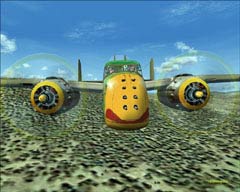
In the South Pacific area of operations, two men by the names of Lt. Col. Paul “Pappy” Gunn and a service representative from NAA by the name of Jack Fox, teamed up for one of those famous “field modifications” of the aircraft. Guns were mounted in the nose of the “Mitchell”. Four .50 cal. machine guns sticking out her snout, and one on each side of the forward aircraft, mounted in a blister pack enabled the Mitchell to send a clear message…of destruction.
The 3rd BG of the 90th BS took this concept of gun arrangement to heart and converted about 12 strafer/bombers, a mix of B-25B’s, C’s, and D’s. Loaded up with parafrag bombs, these aircraft operated in some pretty harsh conditions, but were able to cause quite a bit of havoc on the Japanese forces in the Western Pacific.
The 3rd BG of the 90th BS took this concept of gun arrangement to heart and converted about 12 strafer/bombers, a mix of B-25B’s, C’s, and D’s. Loaded up with parafrag bombs, these aircraft operated in some pretty harsh conditions, but were able to cause quite a bit of havoc on the Japanese forces in the Western Pacific.
"Mimi" is the name of this camo'd version.
The B-25C (a modified “C” that would ultimately become the “G” Model) was the first aircraft to pack a nose mounted cannon on board, 75 mm no less! It ran from the nose, under the pilot, to an area where the navigator could operate the weapon.
When the “ultimate” B-25J model came about, the Mitchell had already made a name for itself as an outstanding gun platform. The “J” Model incorporated no less than eight half inch (.5 in / 12.7mm) in the nose alone, with others scattered about in the tail, sides, and a top turret. Ouch! This last model was also the most produced, numbering around 4300 aircraft. At the end of the war, production of the Mitchell ceased, with nearly 10,000 total Mitchell’s being made.
Here are the overall specs on the Mitchell in its various guises’…
Powerplant:
Two Wright R-2600-13 Double Cyclone fourteen-cylinder air-cooled radials, rated at 1700 hp each for takeoff and 1500 hp at 2400 rpm. Equipped with Holley 1685HA carburetors or Bendix Stromberg carburetors.
When the “ultimate” B-25J model came about, the Mitchell had already made a name for itself as an outstanding gun platform. The “J” Model incorporated no less than eight half inch (.5 in / 12.7mm) in the nose alone, with others scattered about in the tail, sides, and a top turret. Ouch! This last model was also the most produced, numbering around 4300 aircraft. At the end of the war, production of the Mitchell ceased, with nearly 10,000 total Mitchell’s being made.
Here are the overall specs on the Mitchell in its various guises’…
Powerplant:
Two Wright R-2600-13 Double Cyclone fourteen-cylinder air-cooled radials, rated at 1700 hp each for takeoff and 1500 hp at 2400 rpm. Equipped with Holley 1685HA carburetors or Bendix Stromberg carburetors.
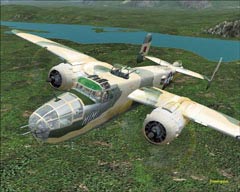
Here's a snoot full of trouble!
Performance:
Maximum speed 275 mph at 15,000 feet. 230 mph cruising speed. Initial climb rate 1110 feet per minute. An altitude of 15,000 feet could be reached in 19 minutes. Service ceiling 24,000 feet. Range 1275 miles with 3200 pounds of bombs. Ferry range 2700 miles.
Armament:
Medium Bomber Version...
One flexible 0.50-inch machine gun in nose, 300 rounds. One fixed 0.50-inch machine gun in nose, 300 rounds. Beginning with B-25J-20, a second fixed 0.50-inch gun was added in the nose.
Strafer Version...
Eight 0.50-inch machine guns in the nose with 400 rpg.
All Versions...
Two 0.50-inch machine guns in individual blisters on the left and right-hand side of the fuselage with 400 rpg. Two 0.50-inch machine guns in top turret, 400 rpg. Two 0.50-inch machine guns in waist position, 200 rpg. Two 0.50-inch machine guns in tail turret, 600 RPG. Normal bomb load was 3000 pounds, but a maximum bomb load of 4000 pounds could be carried on short-range missions. Some had under-wing racks for eight 5-inch high velocity aircraft rockets (HVARs).
Maximum speed 275 mph at 15,000 feet. 230 mph cruising speed. Initial climb rate 1110 feet per minute. An altitude of 15,000 feet could be reached in 19 minutes. Service ceiling 24,000 feet. Range 1275 miles with 3200 pounds of bombs. Ferry range 2700 miles.
Armament:
Medium Bomber Version...
One flexible 0.50-inch machine gun in nose, 300 rounds. One fixed 0.50-inch machine gun in nose, 300 rounds. Beginning with B-25J-20, a second fixed 0.50-inch gun was added in the nose.
Strafer Version...
Eight 0.50-inch machine guns in the nose with 400 rpg.
All Versions...
Two 0.50-inch machine guns in individual blisters on the left and right-hand side of the fuselage with 400 rpg. Two 0.50-inch machine guns in top turret, 400 rpg. Two 0.50-inch machine guns in waist position, 200 rpg. Two 0.50-inch machine guns in tail turret, 600 RPG. Normal bomb load was 3000 pounds, but a maximum bomb load of 4000 pounds could be carried on short-range missions. Some had under-wing racks for eight 5-inch high velocity aircraft rockets (HVARs).
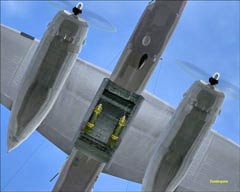
Bomb Bay doors opened.
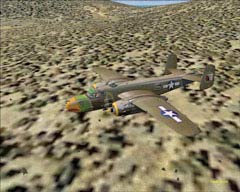
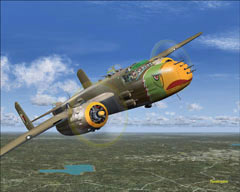
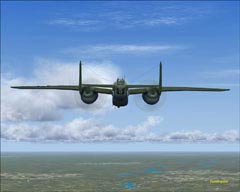
Cruising at low level.
The "Falcon" livery.
A pretty site at any angle!
As you can see, this was an extremely versatile aircraft, serving in a multitude of roles. Many nations other than the USA flew this bird, such as the Royal Air Force and the Soviet Air Force. Other nations utilized the surplus aircraft after the war for their own air forces, with some of the B25’s flying well into the 1950’s.
I’ve only given you a very brief history of this aircraft, but the web is filled with enough information on the topic of the B25 that it will keep you busy for days, if not longer! If you decide to purchase this model from MAAM-SIM, the package is loaded with videos of the actual “Briefing Time” and other good stuff, but more detail on that later in the review. Let’s get started and take a close look at MAAM-SIM’s “Briefing Time”, and a bit if information on the actual bomber.
I’ve only given you a very brief history of this aircraft, but the web is filled with enough information on the topic of the B25 that it will keep you busy for days, if not longer! If you decide to purchase this model from MAAM-SIM, the package is loaded with videos of the actual “Briefing Time” and other good stuff, but more detail on that later in the review. Let’s get started and take a close look at MAAM-SIM’s “Briefing Time”, and a bit if information on the actual bomber.

The model depicted in this product has a history all its own! The actual “Briefing Time” is owned and operated (yep, she’s flyable!), by the Mid-Atlantic Air Museum. The team that put this creation together had the actual aircraft to use for reference, utilizing thousands of digital photos to create the various textures that are seen in the model.
'BRIEFING TIME' (The real one!)
The following is excerpted from "Aircraft of the Mid Atlantic Air Museum" by Pete Malashevitz, the
MAAM Program Director.
“B-25J, "Briefing Time", was assigned to the 57th Bomb Wing, 240th Bomb Group, 489th Squadron, and served in the North African and Italian Campaigns.
The Museum's aircraft restoration is complete with the famous Norden bombsight, operating bomb bay, original radio equipment, and armor plating. Many of the aircraft parts, which are no longer available, had to be fabricated for the restoration to be completed... an example is the top machine gun turret, for which the metal framework and Plexiglas were out of
'BRIEFING TIME' (The real one!)
The following is excerpted from "Aircraft of the Mid Atlantic Air Museum" by Pete Malashevitz, the
MAAM Program Director.
“B-25J, "Briefing Time", was assigned to the 57th Bomb Wing, 240th Bomb Group, 489th Squadron, and served in the North African and Italian Campaigns.
The Museum's aircraft restoration is complete with the famous Norden bombsight, operating bomb bay, original radio equipment, and armor plating. Many of the aircraft parts, which are no longer available, had to be fabricated for the restoration to be completed... an example is the top machine gun turret, for which the metal framework and Plexiglas were out of
production. Museum staff members, working from original drawings fabricated these pieces in order to return the aircraft to its wartime look.
The crew names which appear on the fuselage are those of the crew that flew her first 60 missions. In addition to these missions, "Briefing Time" shares the credit for the sinking of the Italian cruiser, "Taranto".
After becoming surplus in 1959, "Briefing Time" was used as a freight support plane by Tallmantz Inc., in producing such motion pictures as "Around the World in 80 Days". It appeared as "6C" in the motion picture "Catch 22", "War and Remembrance" and has "starred" in six other movies.”
So now that you know a little about the history behind “BT” the aircraft, it’s time to move on to “BT” the Sim!
'Briefing Time' is the primary, full-feature version, with a complete Virtual Cockpit Flight Deck, Bombardier's Nose Compartment, and Upper Turret Gunner's Compartment.
'Briefing Time' - Medium is equipped with the VC Flight Deck, but not the Bombardier's or Upper
Gunner's compartments.
'Briefing Time' - Light has no virtual cockpit at all, for those whose systems can not support the more complex versions and still deliver adequate performance.
Click Here to see my systems specs. I'm not running a "super computer" by any means, but what I do have is more than enough to run "BT" in its full version with great frame rates, i.e. 24 - 28 FPS on average.
The crew names which appear on the fuselage are those of the crew that flew her first 60 missions. In addition to these missions, "Briefing Time" shares the credit for the sinking of the Italian cruiser, "Taranto".
After becoming surplus in 1959, "Briefing Time" was used as a freight support plane by Tallmantz Inc., in producing such motion pictures as "Around the World in 80 Days". It appeared as "6C" in the motion picture "Catch 22", "War and Remembrance" and has "starred" in six other movies.”
So now that you know a little about the history behind “BT” the aircraft, it’s time to move on to “BT” the Sim!
'Briefing Time' is the primary, full-feature version, with a complete Virtual Cockpit Flight Deck, Bombardier's Nose Compartment, and Upper Turret Gunner's Compartment.
'Briefing Time' - Medium is equipped with the VC Flight Deck, but not the Bombardier's or Upper
Gunner's compartments.
'Briefing Time' - Light has no virtual cockpit at all, for those whose systems can not support the more complex versions and still deliver adequate performance.
Click Here to see my systems specs. I'm not running a "super computer" by any means, but what I do have is more than enough to run "BT" in its full version with great frame rates, i.e. 24 - 28 FPS on average.
Excellent paint job and nose art!
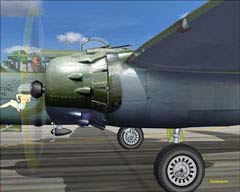
The build of the model is done in a way that allows for good frame rates and still maintains a very detailed, realistic look. Doing a “virtual walk-about”, you may find that you have to remind yourself that you are NOT looking at a real aircraft! This model has been around for a few years, and even though development breakthrough’s in the FS industry has brought about some outstanding aircraft models, the “Briefing Time” model stands right up there still, as far as realism and attention to detail is concerned. Inside and out, you can see the amount of work that has gone into the making of this model.
The use of photorealistic textures adds an incredible amount of detail to the model. Having the “real deal” to go by must have been an invaluable resource in the development phase. The word “textures” covers a wide swath of items, from the obvious paint job on the aircraft, to the textures used for the spinning props. The attention to detail is quite obvious in this area of the model. The screenshots are worth a thousand words!
The use of photorealistic textures adds an incredible amount of detail to the model. Having the “real deal” to go by must have been an invaluable resource in the development phase. The word “textures” covers a wide swath of items, from the obvious paint job on the aircraft, to the textures used for the spinning props. The attention to detail is quite obvious in this area of the model. The screenshots are worth a thousand words!
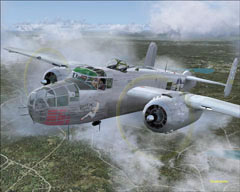
Paint jobs for the model can be found in abundance at the MAAM-SIM site under the title of “Free Stuff” (that title has always appealed to me!). An aluminum textured version as well as a camo version of “Briefing Time” are included in the package. If you are like me, you may find yourself in “Download Nirvana”, as you find everything from tutorial videos featuring the real “Briefing Time”, to loads and loads of paint jobs featuring B-25’s from just about all theaters of war that she participated in! Personally, I have to confess to having no less than 22 paint versions loaded! I enjoy the actual “artwork” that can be seen on the aircraft, and man-oh-man, some of that nose art is simply…well you decide for yourself!
So, you can probably tell that I like the way the model looks, but the serious simmer knows that how a model flies is the really important factor. The development team at MAAM-SIM, all volunteer’s, are long time experts at creating aircraft for Flight Simulator. Actual pilot input was also utilized on the project. The combination of the two makes for an outstanding flight model. If you follow the “book” on how to fly this aircraft model, you’ll see that the model responds quite differently than your “default” aircraft. Take-off procedures are performed a bit differently than most other aircraft. Landings as well take on a different meaning, which entails a slightly different approach. I’m no pilot, but this model makes me think I am! These items are covered in both video and a PDF Manual, along with a copy of an authentic B-25 Manual, all of which are downloadable from the MAAM-SIM site.
One might think that by looking at the list of tutorials and such, that this is going to be one of those models with a long, learning process, while in fact, the information is interesting and actually will enhance your enjoyment of flying the model. It really is not a difficult model to fly, and would be a great “first-buy” for the novice simmer.
So, you can probably tell that I like the way the model looks, but the serious simmer knows that how a model flies is the really important factor. The development team at MAAM-SIM, all volunteer’s, are long time experts at creating aircraft for Flight Simulator. Actual pilot input was also utilized on the project. The combination of the two makes for an outstanding flight model. If you follow the “book” on how to fly this aircraft model, you’ll see that the model responds quite differently than your “default” aircraft. Take-off procedures are performed a bit differently than most other aircraft. Landings as well take on a different meaning, which entails a slightly different approach. I’m no pilot, but this model makes me think I am! These items are covered in both video and a PDF Manual, along with a copy of an authentic B-25 Manual, all of which are downloadable from the MAAM-SIM site.
One might think that by looking at the list of tutorials and such, that this is going to be one of those models with a long, learning process, while in fact, the information is interesting and actually will enhance your enjoyment of flying the model. It really is not a difficult model to fly, and would be a great “first-buy” for the novice simmer.
Zipping through the clouds.
Animated cowling and exhaust effects.
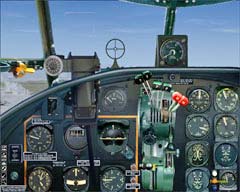
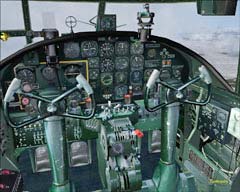





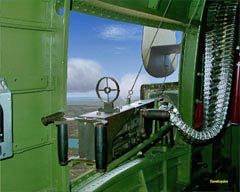
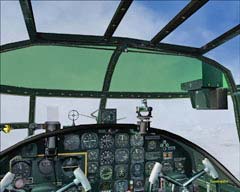
I confess that I still enjoy flying from the 2D panel view in most all aircraft, and “Briefing Time” has what I am going to call a very accurate and artistically rendered panel. About the only thing different on the panel that separates it from the actual panel is the OMI lights having been moved to accommodate some panel design parameters. Other than that, if you get to “know” this model, you would not be a stranger if you happened upon the chance to sit in the cockpit of an actual B25! Access to the co-pilot’s position is utilized to call up certain panels, such as the GPS, and the Cowl Flap Controls, to name a few. This is not done to make it inconvenient for you as you sit in the pilot’s seat. Rather, it reflects the realistic duties of what the co-pilot is responsible for. A view worth mentioning while in the 2D mode is the “up” view with the hat switch. This view will take you to the bombardiers’ position in the nose, and provides for a spectacular view. 2D views also include side views out the waist guns and a rear view that has you looking between the barrels of the top turret guns.
A beautiful 2D cockpit, fully functional.
The Virtual Cockpit is detailed and also very functional.
One other item I would like to mention is the PDI Gauge that sits up at the top of the Pilot’s Panel. Normally this is the gauge that the pilot would watch, as he received directional instructions from the bombardier. In some of the larger bombers, such as the B-17, the bombardier would take over the control of the aircraft upon reaching a point close to the release of the bomb load. Control was minimal, but enough that once the pilot acquired the course inbound to the target area, small adjustments could be made from the bombardier position in the nose, while peeking through the Norden Bombsite. Since you won’t be dropping any metal onto targets, this gauge has been programmed to act as a sort of VOR gauge but with a 45 degree limitation. It comes in handy for picking up ILS signals if you are heading in the right direction. A pleasant surprise was in store for me when I found that my frame rates, even with the incredible amount of detail on the panel, were great, hitting a very smooth 24 - 32 FPS, depending on weather and terrain. Plus the fact that the gauges updated their information quickly and smoothly, I was amazed! Great job in the development department keeping this project at a level of both great performance and great looks!
The Virtual Cockpit environment is just as detailed and operational as the 2D Cockpit. It does not stop there though. You can move about the aircraft with the mouse and the mouse wheel, taking a virtual tour of the Mitchell. Pop on up into the upper turret for a topside view, or “Crawl back through the radioman’s area, drop down, “slide up to the nose of the aircraft, and you’ll have a view that folks pay a small fortune to see in the real aircraft! In the glass nose models, you will see what the bombardier/gunner should see. The use of photorealistic textures here and throughout the plane makes it almost possible to smell the rubber, canvas, and fumes!
The Virtual Cockpit environment is just as detailed and operational as the 2D Cockpit. It does not stop there though. You can move about the aircraft with the mouse and the mouse wheel, taking a virtual tour of the Mitchell. Pop on up into the upper turret for a topside view, or “Crawl back through the radioman’s area, drop down, “slide up to the nose of the aircraft, and you’ll have a view that folks pay a small fortune to see in the real aircraft! In the glass nose models, you will see what the bombardier/gunner should see. The use of photorealistic textures here and throughout the plane makes it almost possible to smell the rubber, canvas, and fumes!
Details from the top down!
Waist Gunner view (Side View).
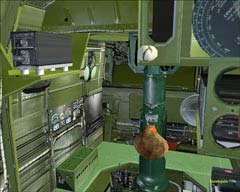
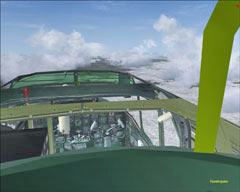
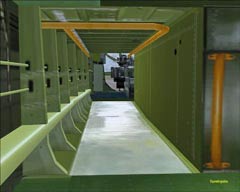
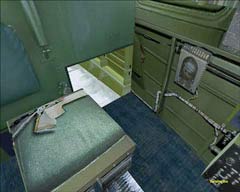
Access tunnel to the nose position.
Night textures.
The "entrance" to the nose psoition.
A view from the upper turret.
In the cockpit...
Animations include the ladder into the belly for the crew when the exit keys are hit, and pressing the Shift + W (usually for the “water rudders” on amphibs) has the pilot pulling in his arm from the open window, giving you a quick thumbs up, and the window closes. Animations of control surfaces are smooth and come with voice call-outs for flap positions and gear status. All very nice touches of detail sinking you deeper into that “immersive” tub of realism!
Exterior lights and interior lights are well displayed. The exterior lights do not have that “Christmas Tree Bulb” effect, but display very realistically. As for the interior lighting, the panel is lit in a nice greenish color, (my personal favorite for panel lighting), and makes reading instruments a very easy task which is mild on the eyes. Viewing the aircraft externally at night also reveals that the nighttime textures look just as good as the daytime textures.
Exterior lights and interior lights are well displayed. The exterior lights do not have that “Christmas Tree Bulb” effect, but display very realistically. As for the interior lighting, the panel is lit in a nice greenish color, (my personal favorite for panel lighting), and makes reading instruments a very easy task which is mild on the eyes. Viewing the aircraft externally at night also reveals that the nighttime textures look just as good as the daytime textures.
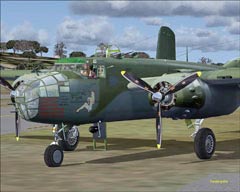
Waiting for the go-ahead!
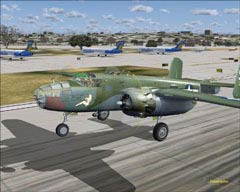
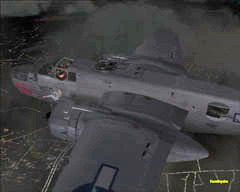
What about the long haul flights? What if you have to use the restroom? OK, there is a pause for the simulator, but…! The actual B-25 had no autopilot; the copilot was there, ready to relieve the pilot. No pop-up autopilot panel is available. However, the development folks went ahead and made the autopilot commands available to you, but only through the use of the keyboard commands. Personally, I enjoy flying this model “hands-on” as it trims out well for a smooth and level flight if flown “by the book”, since that’s how this model was designed to fly.
The sounds are fantastic! When you have a real B-25 at your disposal for recording purposes, it really shows in the quality of all sounds! Authentic start up and idle sounds complete with “pops and bangs”, in-flight engine sounds, call-outs for flaps and gear (a very handy reminder!), all make for a very entertaining environment!
To put it simply, you’ll lose yourself in the realistic environment of this model. Yeah, I know, it’s still a computer screen with an image of an aircraft panel, but with the lights down low, headphones on, and a course to follow…oh yeah, and a little imagination on your part, it’s possible to see yourself as the pilot of your own “Mitchell”!
There are items not covered in this review that are covered in the BT Manual that is available for the model. The manual comes in PDF format and is 113 pages. It is actually a fun read, written by Bill Rambow, a long time MAAM-SIM team member. The manual covers all the in’s and out’s of flying the B-25 Mitchell, along with some comments on how the model was created. Although not necessary for the operation of the model, it is interesting if you are curious about what goes into the making of “Briefing Time”, the product. I’d recommend reading through the entire manual to fully enjoy and understand how to operate this model.
One thing I would like to add before I conclude the review is a great freeware scenery package, which goes by the name of “Doolittle Raid TF16” scenery (vn_tf16.zip). This little gem is brought to you by The Virtual Navy (Bruce Baker & James Smith). This release contains scenery that depicts the ships of Task Force 16 that delivered the Doolittle Raiders to their launch point on April 18th 1942. This scenery was developed in honor of the 62nd anniversary of the raid, and contains the ships that were present the day of the launch.
.
Once you get her nose pointed down the flight deck, you need to get the nose wheel off the deck as soon as possible, riding the main landing gear until you leave the deck of the Stennis. The 50 knot wind that is howling into your face in the sim, aids in getting her off the deck. Once you take off, you need to adjust the weather/wind conditions to something a bit more flyable. I found this out after taking off without reading the ENTIRE set of Readme text!
The sounds are fantastic! When you have a real B-25 at your disposal for recording purposes, it really shows in the quality of all sounds! Authentic start up and idle sounds complete with “pops and bangs”, in-flight engine sounds, call-outs for flaps and gear (a very handy reminder!), all make for a very entertaining environment!
To put it simply, you’ll lose yourself in the realistic environment of this model. Yeah, I know, it’s still a computer screen with an image of an aircraft panel, but with the lights down low, headphones on, and a course to follow…oh yeah, and a little imagination on your part, it’s possible to see yourself as the pilot of your own “Mitchell”!
There are items not covered in this review that are covered in the BT Manual that is available for the model. The manual comes in PDF format and is 113 pages. It is actually a fun read, written by Bill Rambow, a long time MAAM-SIM team member. The manual covers all the in’s and out’s of flying the B-25 Mitchell, along with some comments on how the model was created. Although not necessary for the operation of the model, it is interesting if you are curious about what goes into the making of “Briefing Time”, the product. I’d recommend reading through the entire manual to fully enjoy and understand how to operate this model.
One thing I would like to add before I conclude the review is a great freeware scenery package, which goes by the name of “Doolittle Raid TF16” scenery (vn_tf16.zip). This little gem is brought to you by The Virtual Navy (Bruce Baker & James Smith). This release contains scenery that depicts the ships of Task Force 16 that delivered the Doolittle Raiders to their launch point on April 18th 1942. This scenery was developed in honor of the 62nd anniversary of the raid, and contains the ships that were present the day of the launch.
.
Once you get her nose pointed down the flight deck, you need to get the nose wheel off the deck as soon as possible, riding the main landing gear until you leave the deck of the Stennis. The 50 knot wind that is howling into your face in the sim, aids in getting her off the deck. Once you take off, you need to adjust the weather/wind conditions to something a bit more flyable. I found this out after taking off without reading the ENTIRE set of Readme text!
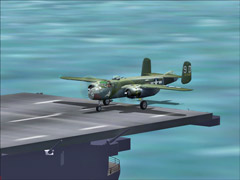
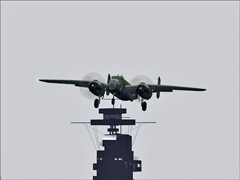
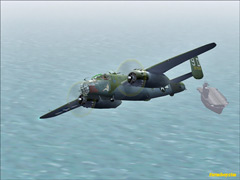
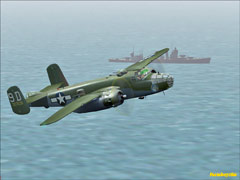
I need all the room I can get!!!
Off the deck and...
...up and away
"What's that B-25 doing way out in the middle of the ocean?"
There are two great reasons to buy this model. First, it’s a great product for the price ($25.00!), and secondly, the money you spend on the “simulated Mitchell” goes right into keeping the real “B-25 Mitchell, Briefing Time” flying to this day, in honor of the men who flew it and the ground crews that kept them in the air. So do yourself and the aviation community a favor, and visit MAAM-SIM, and see their other great products as well, such as the Douglas R4D/DC-3/C-47, MAAM-SIM TBF/TBM Avenger for FS9. A free FSX Basic Compatibility Upgrade for everything except for the TBF/TBM is available on the "Free Stuff" page of MAAM-SIM.










Here's a few more Screenshots of the B-25 Mitchell
Mid-Atlantic Air Museum's
"Mitchell" B-25J Bomber - "Briefing Time"
Reviewed By "Farmboyzim"
"Mitchell" B-25J Bomber - "Briefing Time"
Reviewed By "Farmboyzim"
